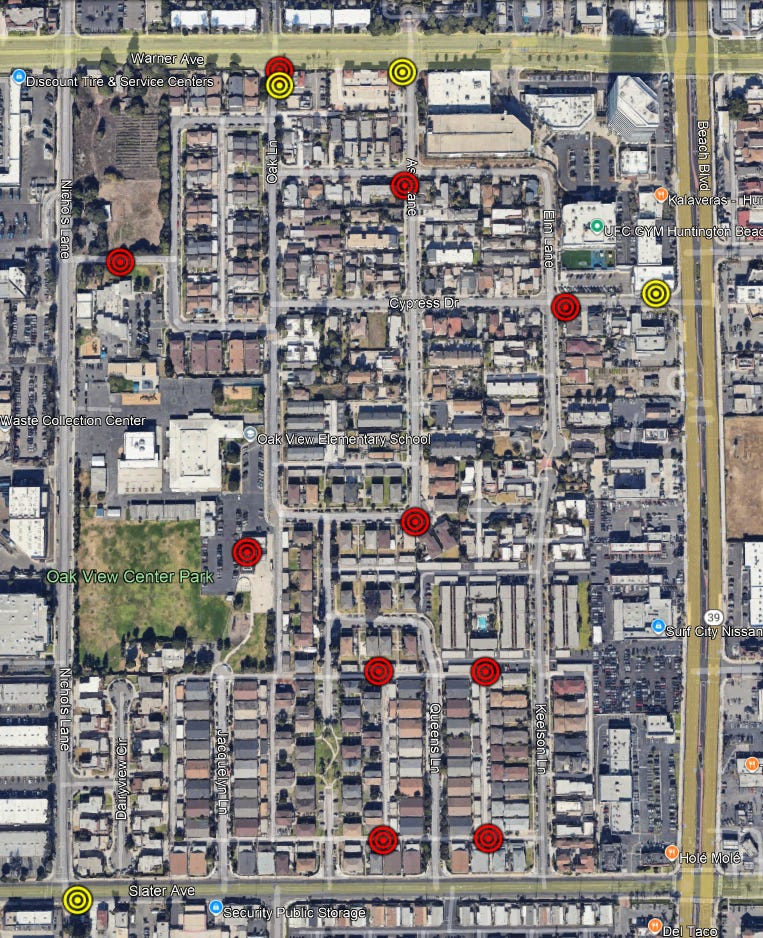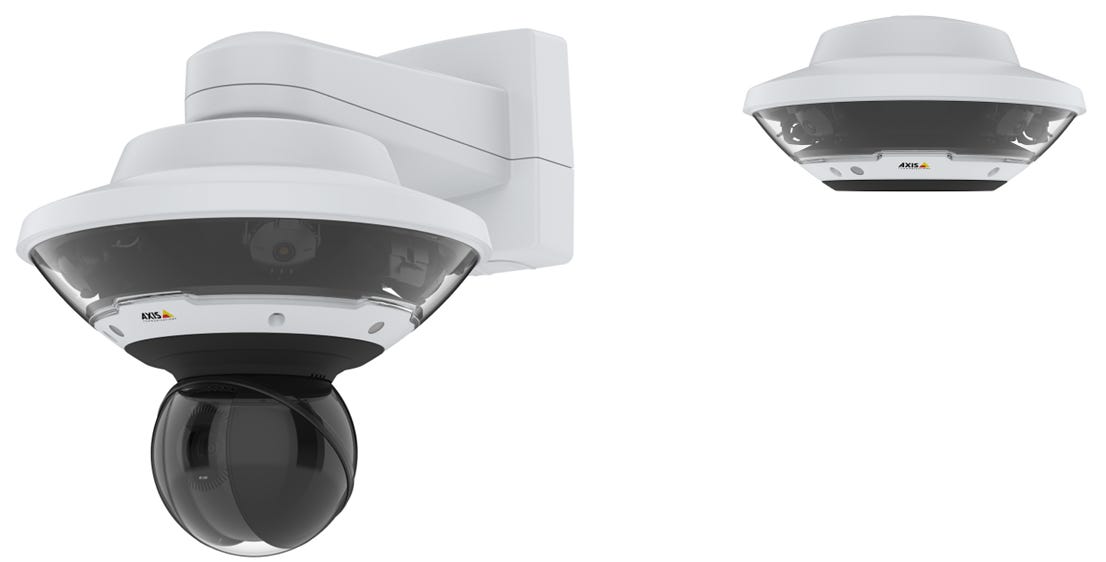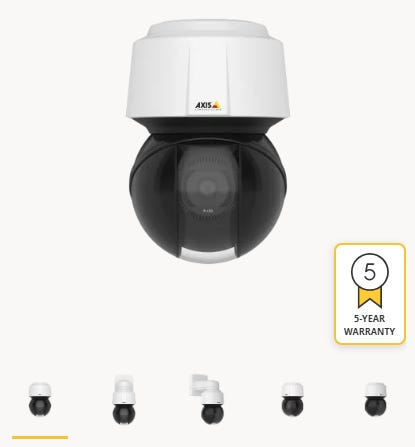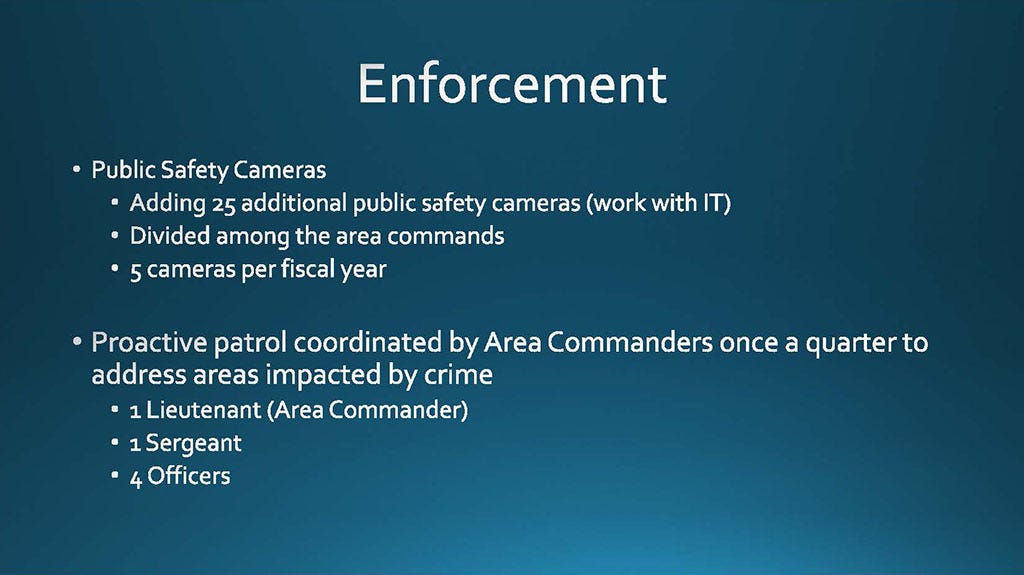Oak View Surveillance Expanded
10 new police cameras are being installed without any public oversight.
I have lived in Huntington Beach for 26 years, which is long enough to know that Oak View, the low-income immigrant neighborhood smack dab in the middle of the city, has problems with crime, up to and including gang activity and murder.
HBPD has long devoted extra resources towards preventing and solving crimes in Oak View, often publicly discussed at city council or neighborhood meetings, with buy-in from neighborhood residents. Oak View was the place where some of the very first automated license plate recognition (ALPR) cameras were installed in the city, and a decade ago I personally attended the city council meeting where that was discussed. For additional info about ALPRs in Huntington Beach, see my Surveillance City Exposed post.
Unfortunately, that level of policing transparency seems to be a thing of the past.
Without any public discussion, 10 new surveillance cameras (noted in red on the map below) are in the process of being installed, with six street cameras already in place, and four alley cameras to come.
The city has not justified their use or explained what safeguards if any will prevent abuse at a time when immigrants and many others are living in very real fear of the government.
I reached out to city hall and gave them 24 hours to comment on the key topics in this article, but I received no response prior to my publication deadline.

Contracting in Secret
On April 3, 2025, city staff simultaneously approved two professional services contracts with Convergint to procure and install the cameras and related IT infrastructure such as radios and server licenses to link the cameras into the city’s camera network.
The cost of the contract for the six street cameras came to $96,058 and the cost of the contract for the four alley cameras came to $50,488, for a grand total of $146,546.
City code requires such contracts that exceed $100,000 to be approved by the city council. But because this surveillance expansion was arbitrarily split into two contracts each valued below that threshold, they never appeared on any city council agenda, hiding them under a cloak of secrecy. They only showed up on my radar because I do a daily spot check of all new city contracts as they appear in the city clerk’s online archives.
This contract splitting fools nobody. It’s all one project, consisting of essentially the same goods and services for 10 locations, but unethically segmented to keep the public in the dark.
These contracts were also not competitively bid, which acts as another layer of secrecy. The fine print in each contract references another government contract which was competitively bid, Sourcewell 030421-CTL, for which the city is leveraging the pricing for most of the contract line items. The few remaining line items not in the Sourcewell contract do not exceed the city threshold that would require competitive bidding. Had it been publicly bid, I would have seen it in my monitoring of the city’s bid portal.
The earliest dates I see mentioned in the city contracts are October 3, 2024, and October 28, 2024, at which time HBPD accepted the pricing for the streets contract and the alleys contract respectively. So, this surveillance project has been percolating for almost a year, predating the election of Trump. Its deployment now, when many Oak View residents are too afraid of the government to leave their homes, is the worst possible timing.
I noticed one oddity in both contracts where the insurance certificate makes reference to the CC-1437 Central Park Parking Lot Improvements contract for which the work was done way back in 2013 and did not appear to involve Convergint. I don’t know what to make of that, but clearly, accuracy problems don’t seem to matter for insurance certificates. Maybe it’s just sloppiness rather than subterfuge. Or maybe insurance certificates in general warrant a deeper dive, because there are games of political favoritism that can be played there.
Camera Details
The four cameras for the alleys bracketing Queens Ln are Axis P3737-PLE Panoramic Cameras:
These cameras are optimized for 360-degree wide-angle monitoring, and have some pan, tilt, and zoom capability. They have infrared illumination, but I was unable to find specs that talk about distance. They have the ability to do audio, but the necessary audio add-on hardware is not a part of the city contract.
The six cameras for the streets are Axis Q6135-LE PTZ Network Cameras:
These powerful pan/tilt/zoom cameras are the top of the Axis line, and the 32x optical zoom will be able to see fine details far in the distance. The city contract says the infrared illumination extends for 660ft, but the Axis web site says 880ft. No matter — those six cameras are clustered such that nowhere in their line of sight will be beyond IR range. They also have the ability to do audio, but the necessary audio add-on hardware is not a part of the city contract.
The Q6135s will be paired with Axis Q6100-E Network Cameras on the same mount:

The Q6100-E serves for wide-area monitoring, and while it can see in near-infrared, it appears to lack IR illumination. Clicking on a wide-angle image from this camera can automatically direct the more powerful Q6135s to automatically zoom in on the target area. They also have the ability to do audio, including being able to point the paired PTZ camera at the source of a sound, but the necessary audio add-on hardware is not a part of the city contract.
Genetec Platform Overview
The new Oak View cameras come with licenses that allow the cameras to be integrated into the city’s Genetec surveillance platform.
The city has used Genetec for more than a decade, with Security Center (the server platform) and Omnicast (video management system) being two of the key products relevant to this post. Additionally, Citigraf is in the process of being rolled out to implement the city’s Real-Time Crime Center (RTCC) which will allow the city to stay on top of fluid situations as they happen.
By virtue of being a market leader, Genetec has a robust partner ecosystem that can augment the Genetec platform with additional functionality such as facial and license plate recognition. I do know that the city uses facial recognition, but I don’t currently know which specific product. Flock is the city’s primary license plate recognition (LPR) platform, but I don’t know if they’re also using LPR on Genetec. It would make sense to use Genetec partner products to be able to do recognition on any city surveillance camera being managed by Genetec.
There isn’t too much discussion in the city archives referring to these company and product names, and so I’ve only seen bits and pieces of how the surveillance technology has been deployed over the years.
Probably the best document in the archives is this 2016 city council request for action (RCA) which talks about expending the number of cameras under Genetec management. The 38 downtown cameras already under Genetec management would be joined by another 85 cameras for the jail and then eventually more cameras around the police department generally, bringing the total number of cameras under Genetec management to 159 if that 2016 project was built out as envisioned.
There has been further camera expansion since 2016, giving the city a lot of eyes in a lot of places. And now there will be 10 more eyes in Oak View.
Should the City be Trusted?
On January 21, 2025, the city council unanimously approved a resolution declaring that Huntington Beach is not a sanctuary city.
The rather racist resolution seems to blame all serious crimes on immigrants, and in part declares that “The City of Huntington Beach, its Police Department, other Departments, and its City officials shall employ and deploy every means and resource necessary to combat crime and protect the citizens of Huntington Beach, including coordinating and communicating with federal law enforcement agencies and honoring ICE detainers”.
So there you have it. The city will use “every means and resource” in “coordinating and communicating” with the feds on immigration. The city is officially all-in on federal immigration enforcement.
A few days later, the city held a town hall meeting for residents to voice their concerns over this policy change. Much of this meeting was conducted in Spanish, and since I am not fluent in Spanish, my summary that follows is based on the captioning machine translation of poor quality audio which may result in translation errors.
HBPD Captain Oscar Garcia opened with a few brief remarks.
Based on Garcia’s hand gestures, I assume the captioning reference to asking for [immigration] papers is a mistranslation and that what he actually said is that HBPD will not be asking about immigration status.
He seems to be saying the right things that in normal times would foster community trust and collaboration when it comes to policing in an immigrant community.
However, these are decidedly not normal times. MAGA politicians and their supporters have redefined “crime” to include crossing the border without permission, turning what is normally a civil offense into a top-priority criminal offense that demands instant deportation without regards for any extenuating circumstances.
City councilmember Gracey Van Der Mark speaks next.
She’s essentially saying that this is only to keep the city safe from dangerous criminals, that people shouldn’t worry, and that they shouldn’t believe the lies about hard-core immigrant enforcement resulting in mass deportations.
How well did Gracey’s words sync up with the ensuing reality? Pretty much not at all, because MAGA is now doing the mass deportations that they said they were going to do.
The feds are deporting landscapers, agricultural workers, car washers, restaurant cooks, and other hard-working people pursuing their American dream. These are hardly the “dangerous criminals” that Gracey and the city council’s resolution are referring to. 7 out of 10 immigrants arrested in June in the LA region lack any criminal convictions on their records. It’s not about public safety.
These immigration raids are using racial profiling to sweep up all who are in the wrong place at the wrong time with the wrong skin tone, surname, or accent. Even citizens have undergone multi-day detentions in deplorable conditions.
There have been many immigration raids within the city, leaving neighborhoods like Oak View living in well-founded fear of the government. Some residents are even too afraid to leave their homes, and so volunteers have organized direct delivery of charitable goods to those affected.
And yet, the city council remains silent as residents’ lives are uprooted.
So, should the city be trusted after the soothing words turned out to be lies without remorse? No.
A Case Study of Poor Surveillance Transparency
Poor transparency when it comes to deployment of surveillance technology is nothing new for HB, as demonstrated by the February 7, 2023 city council meeting.
Agenda item 23-050 is innocuously titled “Report on crime statistics involving Huntington Beach businesses and recommendations to enhance efforts to address and reduce business-related crimes”. Nothing in that title discloses that new surveillance cameras will be deployed.
The staff report blandly refers to a total of 25 “public safety cameras” to be installed at rate of five per year. No mention is made of the camera capabilities or even rough geographical locations.
As to the camera locations, the PowerPoint presentation attached to the agenda item only says they will be “divided among the area commands”, meaning Downtown, Northeast, Northwest, Southeast, and Southwest. Does that mean one new camera per area per year? It doesn’t say.
The video of this agenda item is worth watching in its 10-minute entirety.
When the PowerPoint is presented by HBPD Captain Oscar Garcia, a curious thing happens when he gets to the “Enforcement” slide. The presentation grinds to a halt when he realizes that the wrong slides are being shown, and that greater surveillance ambitions for 50 cameras have just been revealed.
So, now we know thanks to a PowerPoint accident that the city has larger surveillance ambitions than were mentioned in the staff report. Nice. What else aren’t they telling us about those ambitions?
Garcia then resumes speaking to his printout of the agenda packet presentation, referring to 25 cameras over five years, divided among the areas, according to where the most crime is occurring. But there is still no mention of specific locations or camera capabilities.
The ensuing council discussion was fairly brief, but some relevant points were raised.
Councilmember Rhonda Bolton asked about metrics to show effectiveness of the strategy, but Garcia just kind of hand-waved that cameras are “proven” to be effective. No hard data were provided.
Councilmember Natalie Moser was frustrated by the lack of year-over-year comparison data to validate effectiveness or where additional focus is needed. She motioned to table the item until such data could be presented, but the motion died for lack of a second.
Councilmember Dan Kalmick correctly notes that cameras don’t prevent crimes, but may make them easier to solve. He too wants to see more data, and notes that places like London, which has more public safety cameras than most other cities, still have plenty of crime and plenty of unsolved crime. Finally, he points out that there is a bigger discussion to be had about the privacy issues of such cameras and data retention and the like, but the city has never really had that conversation publicly.
The item then passes 7-0 with none of the four MAGA councilmembers voicing any concerns whatsoever, and the hard questions remain unanswered.
I’d like to see the city council do a far better job of surveillance oversight. They should insist that the police provide hard data justifying the need for additional surveillance tools, and they should also insist on hard data to validate effectiveness of previously deployed tools. The public also must be informed in detail about the capabilities of these surveillance systems as well as the tradeoffs like privacy implications.
Government Surveillance is a Threat to Liberty
Police surveillance in Huntington Beach has always expanded and never contracted.
Some of that expansion, i.e. the 10 new cameras for Oak View, is never listed on public meeting agendas, which keeps the public in the dark. What you don’t know can hurt you.
When expansion does show up on a public meeting agenda, it’s couched in soothing euphemisms like “public safety cameras” without details. The decision makers have little appetite to ask hard questions and even less appetite to vote no when the questions go unanswered.
And so police surveillance grows ever larger, almost on autopilot, limited only by budget considerations. Where does it all end? A camera on every corner?
Government surveillance can change from friend to foe in the blink of an election, and we just had one of those elections in 2024.
While the HBPD Policy Manual sets guardrails to prevent abuse of surveillance technology, the police operate within the broader policies set by the city council. And those policies can dramatically change, like the current council declaring that we are not a sanctuary city and that the city will spare no effort to cooperate in federal immigration enforcement.
When the feds come calling for city surveillance data to use for immigration enforcement, they are not bound by our local police policies, and the city will eagerly provide the feds what they came for. Because that is the official policy implemented by the city council.
The 10 new video cameras and the 4 older ALPR cameras are now threats to the residents of Oak View, and the wider surveillance system should be viewed as a threat to us all.






